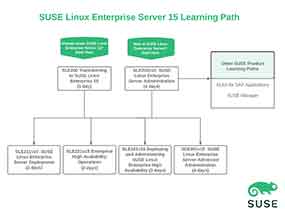SUSE Linux Enterprise 15 High Availability Deployment
Course HAE311v15
This course teaches students to deploy and configure the SUSE Linux Enterprise (SLE) 15 High Availability (HA) product to be ready to deploy workloads. The course introduces the product features and implementation planning for both on premise and public cloud implementations. A SLE15 HA cluster is deployed and then configured to provide corosync network redundancy. Next the fencing configuration is updated which includes adding a quorum arbitrator system. The cluster configuration is then tested before an additional node is added to the existing cluster.
This course prepares students for the SCDS in SUSE Linux Enterprise High Availability exam.
Course Information
Delivery Method: eLearning, Instructor Led Training
Course Duration: 3 days ILT; Approx 21 hours video content
Course Level: Advanced
Key Objectives
During this course you will learn to:
- Plan and prepare to implement a SLE HA cluster
- Install SLE HA and create a Corosync/Pacemaker cluster
- Use the administration tools available to administer a cluster
- Configure node fencing
- Deploy and configure an arbitrator system to provide additional votes to the quorum system
- Add an additional node to an existing cluster
Audience Summary
This course is designed for existing Linux administrators who want to deploy a highly availability cluster using the SUSE Linux Enterprise HA Extension. This course provides a foundation for deploying SAP on SLE 15 HA.
Course Prerequisites
Students require a good knowledge of SLES15. Some familiarity with the basic concepts of clustering for HA would be useful but not required.
Course Outline
- Section 1: Introduction
- Course Objectives and Audience
- Course Lab Environment Overview
- Certification Options
- Additional SUSE Training
- Section 2: Introduction to the SUSE Linux Enterprise High availability Extension
- Overview of the SUSE Linux Enterprise High Availability Extension
- Cluster Terminology
- Overview of the High Availability Extension’s Components
- SLE HA in the Public Cloud
- Section 3: Cluster Implementation planning
- Overview of SLE15 HA Implementation Process
- Collect the Required Parameters
- Set Expectations
- Planning Storage
- 2 Node Clusters, a Special Case
- Designing Test Cases
- Testing and Documentation
- Section 4: Cluster Node Preparation
- Local Filesystems
- Preparing the Infrastructure
- Cluster Networking
- Bonding Configuration
- Time Synchronization
- Name Resolution
- User Management
- Software Management for the HA Environment
- Section 5: Cluster Deployment
- Prepare the Infrastructure
- Deploy the First Cluster Node
- Deploy the Second Cluster Node
- Configure Fault Tolerance for corosync Communications
- Advanced Quorum Configuration with Qdevice and QNetd
- Section 6: Introduction to the Cluster Administration Tools
- Overview of the Cluster Administration Tools
- Introduction to Hawk
- Command Line Tools
- Configure and Synchronize files with csync2
- Section 7: Fencing Concepts and Configuration
- Overview of Split Brain in a Cluster
- Understand Fencing
- STONITH - Shoot the other Node in the Head
- Implement Fencing
- Section 8: Deploy Additional Cluster Nodes
- Prepare a System to become a Cluster Node
- Prepare the Cluster for the New Node
- Add a Node to the Cluster
- Update the Cluster Configuration
